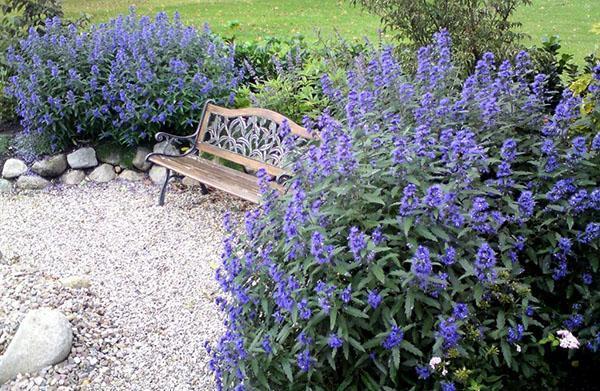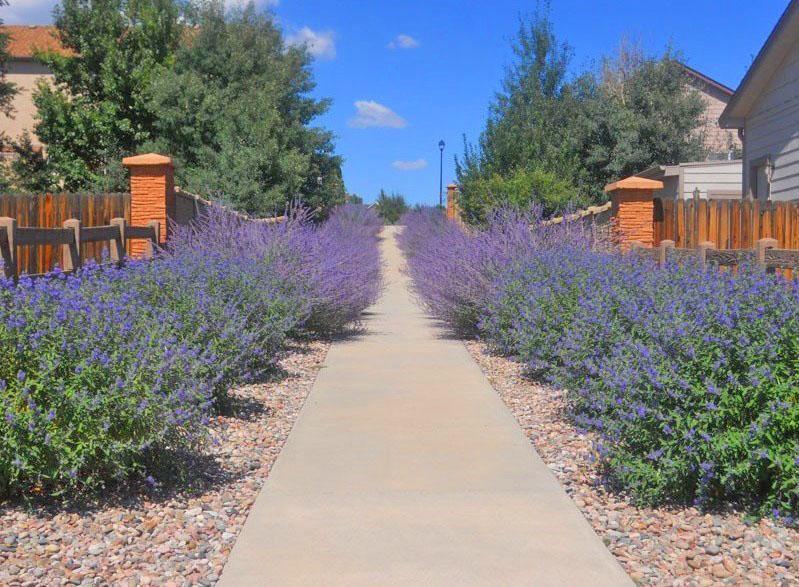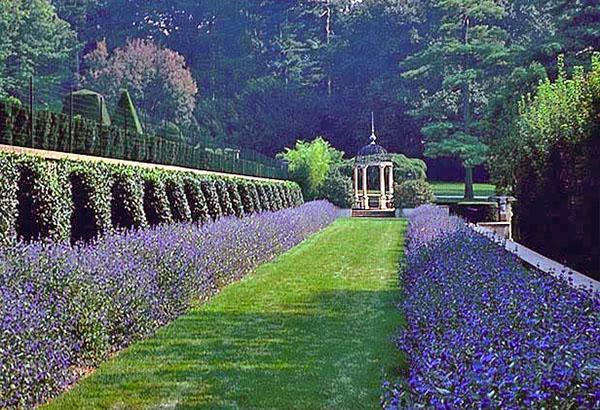Luxurious shrub karyopteris in landscape design
 Very often in the summer cottage there is a space that needs to be filled with something, but the gardener does not know what. In this case, karyopteris or "blue fog" will be an excellent option for solving the problem. The uniqueness of this shrub is that it begins to bloom when its other neighbors in the flowerbed have already faded. Moreover, the decorative properties of the plant are used in landscape design, for example, to decorate avenues in England.
Very often in the summer cottage there is a space that needs to be filled with something, but the gardener does not know what. In this case, karyopteris or "blue fog" will be an excellent option for solving the problem. The uniqueness of this shrub is that it begins to bloom when its other neighbors in the flowerbed have already faded. Moreover, the decorative properties of the plant are used in landscape design, for example, to decorate avenues in England.
In total, there are up to 15 varieties of culture. Each variety differs in the color of not only flowers, but also leaves. Variegated (variegated) exhibits look especially luxurious in the front garden.

Karyopteris - Conqueror of Women's Hearts
 A beautiful and well-kept courtyard is the business card of the owners. You can give your estate a royal charm with the help of the karyopteris shrub, which blooms in all kinds of shades. The neat and compact shape of the crown resembles a hemisphere. On high stems, which can reach from 30 to 150 cm, umbrella inflorescences look exquisite.
A beautiful and well-kept courtyard is the business card of the owners. You can give your estate a royal charm with the help of the karyopteris shrub, which blooms in all kinds of shades. The neat and compact shape of the crown resembles a hemisphere. On high stems, which can reach from 30 to 150 cm, umbrella inflorescences look exquisite.
Depending on the variety, they come in 3 colors:
- blue (Summer Sorbet variety);
- blue or white-green (Forrest);
- purple (Tangut, Sticky and Mongolian).
 In most cases, the culture begins to bloom in August or July. A luxurious cloud of blue or lilac color becomes an original decoration of the front garden until the very frost. Moreover, a rich pine or citrus aroma comes from the flower bed. How to plant this natural decorative element of the garden?
In most cases, the culture begins to bloom in August or July. A luxurious cloud of blue or lilac color becomes an original decoration of the front garden until the very frost. Moreover, a rich pine or citrus aroma comes from the flower bed. How to plant this natural decorative element of the garden?
Growing karyopteris or an unpretentious shrub with character
 For planting walnut (another name), choose a well-lit area or with light partial shade. In shade, the shrub slowly develops, losing the bluish color of the leaves. In addition, the front garden must be protected from wind and drafts. Next, you need to understand the features of planting and caring for karyopteris. Soil selection plays a key role in this.
For planting walnut (another name), choose a well-lit area or with light partial shade. In shade, the shrub slowly develops, losing the bluish color of the leaves. In addition, the front garden must be protected from wind and drafts. Next, you need to understand the features of planting and caring for karyopteris. Soil selection plays a key role in this.
The land under the bush plant should:
- have a loose structure;
- be well drained, so sand is added to the planting hole;
- differ in a slightly acidic or neutral reaction.
 To neutralize soil acidity, a sufficient amount of limestone is applied to the bed. At the same time, in sandy soils, the culture does not take root at all. If you plant a seedling in clay, waterlogged or heavy soil, then very soon its root system will rot, and the bush itself will quickly disappear. Moreover, the wintering of karyopteris under such conditions is destructive, because the remaining water freezes its root.
To neutralize soil acidity, a sufficient amount of limestone is applied to the bed. At the same time, in sandy soils, the culture does not take root at all. If you plant a seedling in clay, waterlogged or heavy soil, then very soon its root system will rot, and the bush itself will quickly disappear. Moreover, the wintering of karyopteris under such conditions is destructive, because the remaining water freezes its root.
The first signs of wilting or plant disease are yellowed, as well as twisted foliage. Also, these symptoms indicate that the seedling did not take root in a new place.
Planting karyopteris seedlings
 By adhering to the basic rules of planting a crop, a florist will be able to avoid many problems with growing a walnut. It is advised to spend it in the last days of April, when it is dry and warm outside. To do this, buy a healthy seedling of Karyopteris Kladonsky or its seeds.
By adhering to the basic rules of planting a crop, a florist will be able to avoid many problems with growing a walnut. It is advised to spend it in the last days of April, when it is dry and warm outside. To do this, buy a healthy seedling of Karyopteris Kladonsky or its seeds.
On the site, shrubs are placed in groups, 2-3 copies in each hole. A distance of 50-60 cm is maintained between them.For a dense planting, they are planted in increments of 15-20 cm.
Having made a markup of the site, the gardener proceeds to garden work:
- digs a hole that is 1.5 times deeper and 3 times wider than the root system of the seedling;
- at the bottom forms drainage from humus or sand (up to 10 cm);
- puts a young plant in the center of the fossa;
- delicately spreads the roots;
- fills them with soil mixture;
- water abundantly.
It is recommended to plant seedlings in the spring. If the specimen is purchased in the fall, then it is placed in a temporary pot of soil mixture and sent to a cool room for storage.
When buying crop seedlings, it is important to choose non-flowering specimens. Such specimens are resistant to anomalous phenomena, so they quickly take root in a new place. In addition, the presence of yellowed leaves on the bush indicates that the plant is sick and does not need to be planted.
Planting karyopteris by seed is a laborious process
 Some will want to sow karyopteris seeds outdoors. Late autumn will be the right time for this.
Some will want to sow karyopteris seeds outdoors. Late autumn will be the right time for this.
Cultivation of a nutlet by the seedling method is carried out in early spring:
- seeds are sown in pots, simply scattering them over the surface of the earth;
- spray the planting from a spray bottle;
- covered with a film, which is removed every day for airing and watering;
- when sprouts appear, the "mini-greenhouse" is removed;
- The pick is carried out when the plant forms 3-4 full leaves.
The seedlings are transferred to the flower bed in the first half of May. At the same time, they adhere to the planting rules as for seedlings. Water the site only in dry weather, adding a moderate amount of liquid.
Cariopteris care - we create a beauty salon for culture
 Although a shrub from the family of clear-flowered and unpretentious to the soil, it still needs to be fed periodically. For this, complex mineral fertilizers are used. At the same time, every month they contribute organic (humus or compost) to stimulate plant growth and development.
Although a shrub from the family of clear-flowered and unpretentious to the soil, it still needs to be fed periodically. For this, complex mineral fertilizers are used. At the same time, every month they contribute organic (humus or compost) to stimulate plant growth and development.
It is worth knowing that with the regular introduction of mineral mixtures, a lot of salts settle in the ground. These compounds violate the microflora of the soil, suppressing the activity of its microorganisms. Reducing the concentration of salts can only be done with watering.
 One of the most important procedures for caring for a shrub will be its timely pruning, which is carried out every spring. This event is extremely necessary, because only on young shoots will flower ovaries form.
One of the most important procedures for caring for a shrub will be its timely pruning, which is carried out every spring. This event is extremely necessary, because only on young shoots will flower ovaries form.
The principles of this process are simple:
- Shoots are shortened in March, when the plant has not yet begun to actively develop.
- Dry stems are harvested in the fall immediately after flowering.
- If during the winter the branches of the bush are frozen, then they are cut to the very base.
- Every 4 years, a rejuvenating "haircut" is performed. The height of such shoots is left at a height of 10 cm from the ground.
All these procedures will help to create a compact and beautiful bush that will look amazing on a flower bed. However, in order to create an original landscape design, it is important to choose a suitable crop variety.
Kariopteris Klandonensky is a regular guest of Moscow dachas
 In nature, there are about 15 species of the walnut. However, only 2 of them are used in the northern strip of Russia. The most popular are "Caryopteris incana" or gray-haired, as well as karyopteris Klandonensky, which was obtained by crossing Mongolian and gray-haired varieties. On its high stems (up to 1 m), dark green leaves with original pubescence are located oppositely. The apical inflorescences bloom in July and fascinate all passers-by with their lilac-blue buds.
In nature, there are about 15 species of the walnut. However, only 2 of them are used in the northern strip of Russia. The most popular are "Caryopteris incana" or gray-haired, as well as karyopteris Klandonensky, which was obtained by crossing Mongolian and gray-haired varieties. On its high stems (up to 1 m), dark green leaves with original pubescence are located oppositely. The apical inflorescences bloom in July and fascinate all passers-by with their lilac-blue buds.
Although the Klandon variety tolerates wintering well, it is still recommended to transfer the bushes to containers in more severe climatic conditions. The seedlings are placed in cool rooms (6-10˚C), but with sufficient lighting.
 A distinctive feature of some varieties of the nut-calla is not only the original inflorescence, but also the amazing color of the foliage.The variety of variegated karyopteris, which surprises with its decorative properties, is especially popular.
A distinctive feature of some varieties of the nut-calla is not only the original inflorescence, but also the amazing color of the foliage.The variety of variegated karyopteris, which surprises with its decorative properties, is especially popular.
By planting this type of shrub, gardeners will receive:
- luxurious bush 80-100 cm high;
- a deep blue bouquet of flowers that will adorn the club until cold weather;
- a prototype of Benjamin's variegated ficus.
Its oval leaves have jagged edges and come in 2 vibrant shades. In landscape design, dark green leaves with a yellow edging look great.
The main pests of walnut are horseflies, which leave dashed lines on the leaves. Treating the foliage with a fungicide will help get rid of insects. At the same time, excess moisture in the soil can lead to rotting of the root system.
In addition to the listed features of planting and care, karyopteris does not need anything else. But with the help of this shrub, the gardener will be able to decorate the empty areas of the garden, which often spoil the landscape design of the cottage.